Wai-Fah Chen.The Civil Engineering Handbook
Подождите немного. Документ загружается.

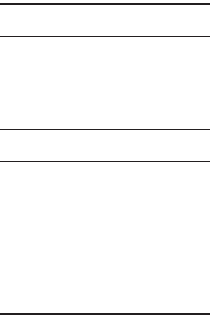
15
-2
The Civil Engineering Handbook, Second Edition
The grain-size characteristics of soils that are predominantly coarse grained are evaluated by a
sieve
analysis.
A
nest of sieves
is prepared by stacking sieves one above the other with the largest opening at
the top followed by sieves of successively smaller openings and a catch pan at the bottom. Opening sizes
of commonly used sieves are shown in Table 15.1. A sample of dry soil is poured onto the top sieve, the
nest is covered, and it is then shaken by hand or mechanical shaker until each particle has dropped to a
sieve with openings too small to pass, and the particle is
retained.
The cumulative weight of all material
larger than each sieve size is determined and divided by the total sample weight to obtain the
percent
retained
for that sieve size, and this value is subtracted from 100% to obtain the
percent passing
that sieve
size. Results are displayed by plotting the percent passing (on a linear scale) against the sieve opening
size (on a log scale) and connecting the plotted points with a smooth curve referred to as a
grain-size
distribution curve.
A sample of some grain-size distribution curves is presented in Fig. 15.1.
The notation
D
xx
refers to the size
D , in mm, for which
xx percent of the sample by weight passes a
sieve with an opening equal to
D . The
D
10
size, sometimes called the effective grain size, is the grain
diameter for which 10% of the sample (by weight) is finer. It is determined from the grain-size distribution
curve at the point where the curve crosses a horizontal line through the 10% passing value on the
y
axis.
Other
D sizes are found in a similar manner. The D
50
size, called the median grain size,
is the grain
diameter for which half the sample (by weight) is smaller and half is larger.
Two parameters are used to describe the general shape of the grain-size distribution curve. The
coefficient of uniformity,
C
u
, is:
(15.1)
The
coefficient of curvature,
C
c
, is:
(15.2)
Atterberg Limits and Plasticity
Atterberg limits, named after the Swedish soil scientist A. Atterberg, are water content values at which
notable changes in soil behavior occur. The
liquid limit , denoted LL or
w
L
, marks the transition between
liquid and plastic behavior. At water contents above the liquid limit the soil behaves as a viscous liquid;
below the liquid limit the soil behaves as a plastic solid. The liquid limit is determined in the laboratory
by partly filling a standard brass cup with wet soil and cutting a groove of a standard dimension in the
TA BLE 15.1
Opening Sizes
of Commonly Used Sieves
Inches Millimeters
1.5 37.5
125
0.75 19
0.5 12.5
Sieve No. Millimeters
4 4.75
10 2.00
20 0.850
40 0.425
70 0.212
100 0.150
200 0.075
C
u
D
60
D
10
--------=
C
c
D
30
2
D
60
D
10
¥
----------------------=
© 2003 by CRC Press LLC
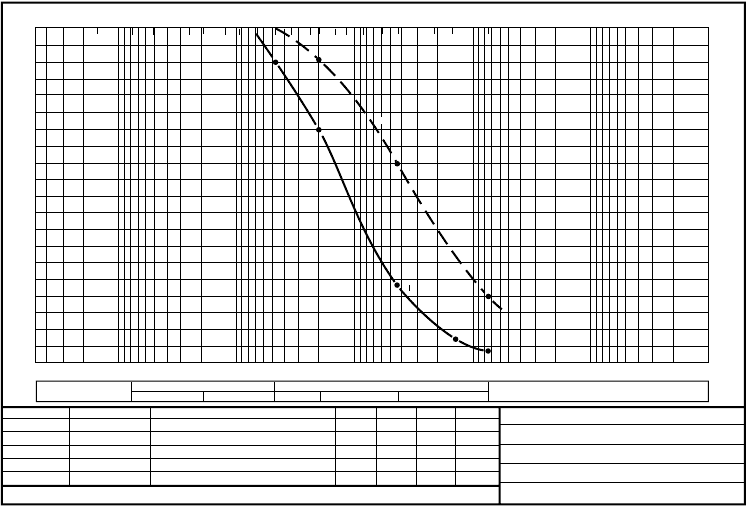
Soil Relationships and Classification
15
-3
soil. The liquid limit is taken as the water content at which the groove closes a specified amount when
the cup is lifted and dropped 1 cm exactly 25 times. The details of the test are given in AASHTO T 89
and ASTM D 4318-93. The
plastic limit
, denoted PL or
w
p
, is the transition between plastic and brittle
behavior. It is determined in the laboratory as the water content at which a 1/8-inch diameter thread of
soil begins to crumble when rolled under the palm of the hand. Details of the liquid limit and plastic
limit tests are provided by AASHTO T 90 and ASTM D 4318-93. The
shrinkage limit
, denoted SL or
w
S
, is the water content below which the soil no longer reduces in volume when the water content is
reduced. Although Atterberg limits are water contents and are properly decimals or percentages, they are
usually expressed as an integer percentage without a percent sign. Thus, a liquid limit of 40% is usually
reported as LL = 40.
The
plasticity index
, denoted PI or
I
P
, is the difference of the liquid limit and the plastic limit:
(15.3)
The
liquidity index
, denoted LI or
I
L
, is a measure of the natural water content (
w
) relative to the
plastic limit and the liquid limit:
(15.4)
The Unified Soil Classification System (USCS)
The Unified Soil Classification System is based on the airfield classification system developed by
A. Casagrande during World War II. With some modification it was jointly adopted by several U.S.
government agencies in 1952. Additional refinements were made and it is currently standardized as ASTM
D 2487-93. It is used in the U.S. and much of the world for geotechnical work other than roads and
highways.
FIGURE 15.1
Typical grain size distribution curves. (From U.S. Army, 1970.)
GRADATION CURVES
DATE
BORING NO.
AREA
PROJECT
SILT OR CLAY
500 100 50 10 5 1 0.5 0.1 0.05 0.01 0.005 0.001
0
10
20
30
40
50
60
70
80
90
100
0
10
20
30
40
50
60
70
80
90
100
PER CENT FINER WEIGHT
PER CENT COARSER BY WEIGHT
U.S. STANDARD SIEVE OPENING IN INCHES U.S. STANDARD SIEVE NUMBERS HYDROMETER
6
4
3
2
1
1
3
4
6
8 10
14
16
20
30 40
50
70
100140
200
GRAVEL
FINE
SAND
COARSE MEDIUM FINE
PIPL
LLNAT W%CLASSIFICATION
ELEV OR DEPTHSAMPLE NO.
COBBLES
COARSE
GRAIN SIZE MILLIMETERS
ENG FORM
1 MAY 63
2087
1
/
2
1
/
2
3
/
4
3
/
6
PI LL P– L=
LI I
L
w P– L
LL P– L
----------------------==
© 2003 by CRC Press LLC
15
-4
The Civil Engineering Handbook, Second Edition
In the unified system soils are designated by a two-letter symbol: the first identifies the primary
component of the soil, and the second describes its grain size or plasticity characteristics. For example,
a poorly graded sand is designated SP and a low plasticity clay is CL. Five first-letter symbols are used:
Gfor gravel
Sfor sand
Mfor silt
Cfor clay
Ofor organic soil
Clean sands and gravels (having less than 5% passing the No. 200 sieve) are given a second letter P if
poorly graded or W if well graded. Sands and gravels with more than 12% by weight passing the No. 200
sieve are given a second letter M if the fines are silty or C if fines are clayey. Sands and gravels having
between 5 and 12% are given dual classifications such as SP-SM. Silts, clays, and organic soils are given
the second letter H or L to designate high or low plasticity. The specific rules for classification are
summarized as follows and described in detail in ASTM D 2487.
Organic soils are distinguished by a dark-brown to black color, an organic odor, and visible fibrous
matter.
For soils that are not notably organic the first step in classification is to consider the percentage passing
the No. 200 sieve. If less than 50% of the soil passes the No. 200 sieve, the soil is
coarse grained,
and the
first letter will be G or S; if more than 50% passes the No. 200 sieve, the soil is
fine grained
and the first
letter will be M or C.
For coarse-grained soils, the proportions of sand and gravel in the
coarse fraction
(not the total
sample) determine the first letter of the classification symbol. The coarse fraction is that portion of the
total sample retained on a No. 200 sieve. If more than half of the coarse fraction is gravel (retained on
the No. 4 sieve), the soil is
gravel
and the first letter symbol is G. If more than half of the coarse fraction
is sand, the soil is
sand
and the first letter symbol is S.
For sands and gravels the second letter of the classification is based on gradation for clean sands and
gravels and plasticity of the fines for sands and gravels with fines. For clean sands (less than 5% passing
the No. 200 sieve), the classification is well-graded sand (SW) if
C
u
≥
6
and
1
£
C
c
£
3.
Both of these
criteria must be met for the soil to be SW, otherwise the classification is poorly graded sand (SP). Clean
gravels (less than 5% passing the No. 200 sieve) are classified as well-graded gravel (GW) if C
u
≥ 4 and
1 £ C
c
£ 3. If both criteria are not met, the soil is poorly graded gravel (GP).
For sands and gravels where more than 12% of the total sample passes the No. 200 sieve, the soil is a
clayey sand (SC), clayey gravel (GC), silty sand (SM), or silty gravel (GM). The second letter is assigned
based on whether the fines classify as clay (C) or silt (M) as described for fine-grained soils below.
For sands and gravels having between 5 and 12% of the total sample passing the No. 200 sieve, both
the gradation and plasticity characteristics must be evaluated and the soil is given a dual classification
such as SP-SM, SP-SC, GW-GC, etc. The first symbol is always based on gradation, whereas the second
is always based on plasticity.
For fine-grained soils and organic soils, classification in the unified system is based on Atterberg limits
determined by the fraction passing the No. 40 sieve. The liquid limit and plasticity index are determined
and plotted on the plasticity chart (Fig. 15.2). The vertical line at LL = 50 separates high-plasticity soils
from low-plasticity soils. The A-line separates clay from silt. The equation of the A-line is PI =
0.73(LL – 20). The U-line is not used in classification but is an upper boundary of expected results for
natural soils. Values plotting above the U-line should be checked for errors.
Inorganic soils with liquid limits below 50 that plot above the A-line and have PI values greater than 7
are lean clays and are designated CL; those with liquid limits above 50 that plot above the A-line are fat
clays and are designated CH. Inorganic soils with liquid limits below 50 that plot below the A-line are
silt and are designated ML; those with liquid limits above 50 that plot below the A-line are elastic silts
and are designated MH. The plasticity chart has a shaded area; soils that plot in this area (above the
A-line with PI values between 4 and 7) are silty clay and are given the dual symbol CL-ML. If the soil
© 2003 by CRC Press LLC
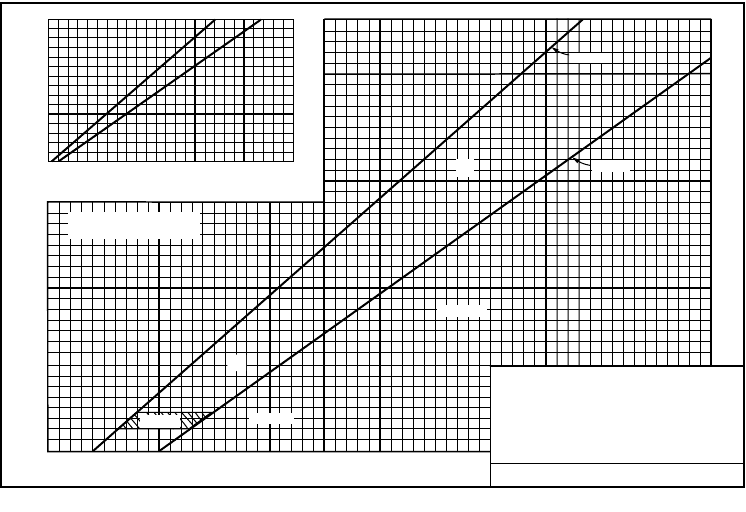
Soil Relationships and Classification 15-5
under consideration is the fines component of a dually classified sand or gravel, the soil is classified as
SM-SC or GM-GC.
Soils with sufficient organic contents to influence properties that have liquid limits below 50 are
classified as OL; those with liquid limits above 50 are classified as OH. Soils that are predominantly
organic, with visible vegetable tissue, are termed peat and given the designation Pt.
The AASHTO Classification System
The AASHTO system classifies soils into seven primary groups, named A-1 through A-7, based on their
relative expected quality for road embankments, subgrades, subbases, and bases. Some of the groups are
in turn divided into subgroups, such as A-1-a and A-1-b. Furthermore, a group index may be calculated
to quantify a soil’s expected performance within a group.
To determine a soil’s classification in the AASHTO system, one first determines the relative proportions
of gravel, coarse sand, fine sand, and silt-clay. In the AASHTO system gravel is material smaller than
75 mm (3 in.) but retained on a No. 10 sieve; coarse sand is material passing a No. 10 sieve but retained
on a No. 40 sieve; and fine sand is material passing a No. 40 sieve but retained on a No. 200 sieve. Material
passing the No. 200 sieve is silt-clay and is classified based on Atterberg limits. It should be noted that
the division between gravel and sand is made at a smaller size (No. 10 sieve) in the AASHTO system
than in the unified system (No. 4 sieve). Secondly, if any fines are present, Atterberg limits are determined
and the plasticity index is calculated.
A soil is a granular material if less than 35% of the soil by weight passes the No. 200 sieve. Granular
materials are classified into groups A-1 through A-3. Soils having more than 35% passing the No. 200
sieve are silt-clay and fall in groups A-4 through A-7.
Having the proportions of the components and the plasticity data, one enters one of the two alternative
AASHTO classification tables (Tables 15.2 and 15.3) and checks from left to right until a classification
is found for which the soil meets the criteria. It should be noted that, in this scheme, group A-3 is checked
before A-2. The AASHTO plasticity criteria are also illustrated in Fig. 15.3.
FIGURE 15.2 Plasticity chart for Unified Soil Classification System. (From U.S. Army, 1970.)
300
200
100
100 200 300 400 500
0
0
LIQUID LIMIT, LL
U-LINE: PI = 0.9(LL - 8)
A-LINE: PI = 0.73(LL - 20)
LIQUID LIMIT, LL
PLASTICITY CHART
PLASTICITY INDEX, PI
40
30
20
10
0
CL - ML
100203040506070
CL
CH
A-LINE
U-LINE
UA
50
50 60 70 80 90 100 110 120
60
70
80
20
30
40
50
60
70
80
MH & OH
ML & OL
ENG FORM
JUNE 1970
4334
© 2003 by CRC Press LLC
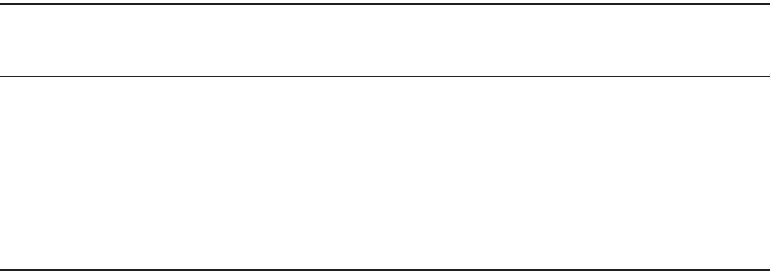
15-6 The Civil Engineering Handbook, Second Edition
Soils classified as A-1 are typically well-graded mixtures of gravel, coarse sand, and fine sand. Soils in
subgroup A-1-a contain more gravel whereas those in A-1-b contain more sand. Soils in group A-3 are
typically fine sands that may contain small amounts of nonplastic silt. Group A-2 contains a wide variety
of “borderline” granular materials that do not meet the criteria for groups A-1 or A-3.
Soils in group A-4 are silty soils, whereas those in group A-5 are high-plasticity elastic silt. Soils in
group A-6 are typically lean clays, and those in group A-7 are typically highly plastic clays.
Within groups containing fines, one may calculate a group index to further evaluate relative quality
and supporting value of a material as subgrade. The group index is calculated according to the following
empirical formula:
(15.5)
In this equation F is the percentage of fines (passing the No. 200 sieve) expressed as a whole number.
When calculating the group index for A-2-6 and A-2-7, only the PI term is used. The group index is
rounded to the nearest whole number and, if negative, it is taken as zero. The expected performance is
inversely related to group index. A value of zero indicates a good subgrade material and a value above
20 indicates a very poor material.
Example 15.1
Classify the soil shown by the solid curve in Fig. 15.1. Assume the soil is nonplastic. The following data
are obtained:
Percent passing No. 4 sieve: 90%
Percent passing No. 10 sieve: 70%
Percent passing No. 40 sieve: 23%
Percent passing No. 200 sieve: 4%
D
60
size: 1.50 mm
D
30
size: 0.61 mm
D
10
size: 0.18 mm
To classify the soil in the Unified Soil Classification System, the percent passing the No. 200 sieve is
first checked. As only 4% passes the No. 200 sieve, the soil is coarse grained. The coarse fraction makes
up 96% of the soil, with 10% being gravel (larger than the No. 4 sieve) and 86% being sand (the difference
between the Nos. 4 and 200 sieves). As there is more sand than gravel, the soil is a sand and the first
letter is S.
TABLE 15.2 Classification of Soils and Soil-Aggregate Mixtures by the AASHTO System
General Classification
Granular Materials
(35% or Less Passing 0.075 mm)
Silt-Clay Materials
(More than 35% Passing 0.075 mm)
Group Classification A-1 A-3
a
A-2 A-4 A-5 A-6 A-7
Sieve analysis, percent passing:
2.00 mm (No. 10) — — — ————
0.425 mm (No. 40) 50 max. 51 min. — ————
0.075 mm (No. 200) 25 max. 10 max. 35 max. 36 min. 36 min. 36 min. 36 min.
Characteristics of fraction passing
0.425 mm (No. 40)
Liquid limit — — 40 max. 41 min. 40 max. 41 min.
Plasticity index 6 max. N.P. b 10 max. 10 max. 11 min. 11 min.
General rating as subgrade Excellent to good Fair to poor
a
The placing of A-3 before A-2 is necessary in the “left to right elimination process” and does not indicate superiority
of A-3 over A-2.
b
See Table 15.3 for values.
From Standard Specification for Transportation Materials and Methods of Sampling and Testing. Copyright 1990 by the
American Association of State Highway and Transportation Officials, Washington, D.C. Used by permission.
Group index F 35–()0.2 0.005 LL 40–()+[] + 0.01 F 15–()PI 10–()=
© 2003 by CRC Press LLC

Soil Relationships and Classification 15-7
TA BLE 15.3 Classification of Soils and Soil-Aggregate Mixtures
General Classification
Granular Materials
(35% or Less Passing 0.075 mm)
Silt-Clay Materials
(More than 35% Passing 0.075 mm)
A-1 A-2 A-7
Group Classification A-1-a A-1-b A-3 A-2-4 A-2-5 A-2-6 A-2-7 A-4 A-5 A-6 A-7-5, A-7-6
Sieve analysis, percent passing:
2.00 mm (No. 10) 50 max. —————— — —— —
0.425 mm (No. 40) 30 max. 50 max. 51 min. ———— — —— —
0.075 mm (No. 200) 15 max. 25 max. 10 max. 35 max. 35 max. 35 max. 35 max. 36 min. 36 min. 36 min. 36 min.
Characteristics of fraction
passing 0.425 mm (No. 40)
Liquid limit — — 40 max. 41 min. 40 max. 41 min. 40 max. 41 min. 40 max. 41 min.
Plasticity index 6 max. N.P. 10 max. 10 max. 11 min. 11 min. 10 max. 10 max. 11 min. 11 min.
a
Usual types of significant
constituent materials
Stone fragments,
gravel, and sand
Fine
sand
Silty or clayey gravel and sand Silty soils Clayey soils
General rating as subgrade Excellent to good Fair to poor
a
Plasticity index of A-7-5 subgroup is equal to or less than LL minus 30. Plasticity index of A-7-6 subgroup is greater than LL minus 30.
From Standard Specification for Transportation Materials and Methods of Sampling and Testing. Copyright 1990 by the American Association of State Highway and
Tr ansportation Officials, Washington, D.C. Used by permission.
© 2003 by CRC Press LLC
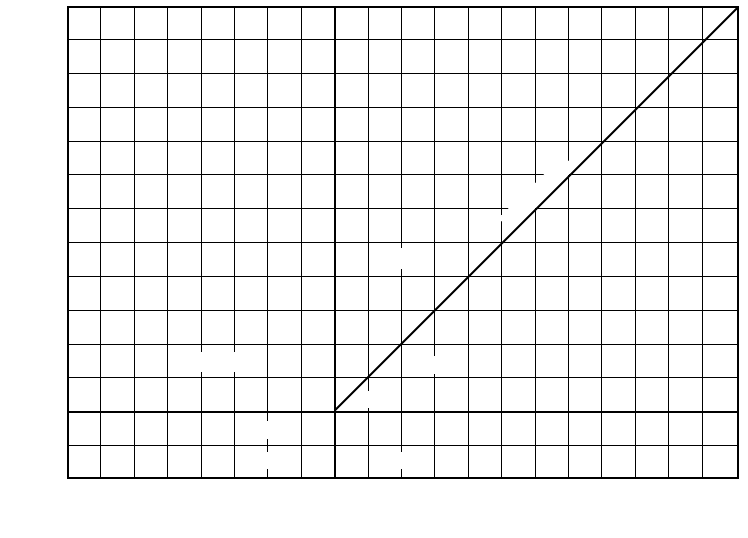
15-8 The Civil Engineering Handbook, Second Edition
As less than 5% passes the No. 200 sieve, the sand is clean (SP or SW). The coefficient of uniformity
is (1.5)/(0.18) = 8.33. The coefficient of curvature is 0.61
2
/(1.5)(0.18) = 1.38. As the coefficient of
uniformity is greater than 6.0 and the coefficient of curvature is between 1 and 3, the soil meets both of
the criteria for SW and is so classified.
In the AASHTO system the soil is 30% gravel, 47% coarse sand, 19% fine sand, and 4% silt-clay.
Proceeding from left to right on the classification chart, the soil cannot be classified as A-1-a because the
soil has 70% passing the No. 10 and that classification permits a maximum of 50%. The soil meets the
classification criteria for A-1-b and is so classified.
Example 15.2
Classify the soil represented by the dashed curve in Fig. 15.1. The liquid limit and plastic limit are found
to be 30 and 20, respectively. The following data are obtained:
Percent passing No. 4 sieve: 100%
Percent passing No. 10 sieve: 91%
Percent passing No. 40 sieve: 60%
Percent passing No. 200 sieve: 20%
D
60
size: 0.41 mm
D
30
size: 0.12 mm
D
10
size: <0.074 mm
Liquid limit: 30
Plastic limit: 20
FIGURE 15.3 Plasticity chart for AASHTO Classification System. (From Standard Specification for Transportation
Materials and Methods of Sampling and Testing. Copyright 1990 by the American Association of State Highway and
Tr ansportation Officials, Washington, D.C. Used by permission.)
0
0
10
10 20 30 40 50 60 70 80 90 100
LIQUID LIMIT
PLASTICITY INDEX
20
30
A–6
A–4
A–2–6
A–2–4
A–5
A–2–5
A–2–7
A–7–5
A–7–6
PI = LL – 30
40
50
60
70
© 2003 by CRC Press LLC

Soil Relationships and Classification 15-9
First the soil is classified by the Unified Soil Classification System. As only 20% of the soil is smaller
than a No. 200 sieve, the soil is coarse grained. All of the coarse fraction is smaller than the No. 4 sieve,
so the soil is sand (first letter S).
As the percentage passing the No. 200 sieve is greater than 12%, the gradation characteristics are not
considered, and the Atterberg limits are examined to determine whether the sand is a clayey sand or silty
sand. The plasticity index is calculated as 30 – 20 = 10, and the coordinates LL = 30, PI = 10 are entered
on the plasticity chart. As this plots in the CL region, the fines are clay and the soil is a clayey sand SC.
Next the soil is classified according to the AASHTO system. Following the classification table from left
to right, group A-1 is eliminated due to too much material passing the No. 40 sieve, and group A-3 is
eliminated due to too much material passing the No. 200 sieve. The soil passes the criteria for A-2-4 and
is so classified. The group index is calculated as:
where F = 20, the percent passing the No. 200 sieve. Thus:
This is rounded to the nearest whole number, 2, and the soil classification is reported as A-2-4(2).
Example 15.3
A fine-grained soil has the following properties:
Percent passing No. 200 sieve: 65%
Liquid limit: 60
Plastic limit: 28
First the soil is classified according to the unified system. As more than 50% of the sample passes the
No. 200 sieve, the soil is fine grained and the plasticity chart is used. The plasticity index is 60 – 28 = 32.
The coordinates (60, 32) plot in the CH region, so the soil is a high-plasticity clay (CH).
To c lassify the soil in the AASHTO system, one notes that more than 35% passes the No. 200 sieve,
so the soil is silt-clay. Entering the coordinates (60, 32) on the AASHTO plasticity chart, the classification
is A-7-6. The group index is calculated as follows:
The complete classification is A-7-6(20), which indicates a poor quality soil for highway construction.
15.2 Weight, Mass, and Volume Relationships
In an engineering context, soil comprises three components: solid particles, water, and air. Many problems
in soil mechanics and construction quality control involve making calculations and communicating
information regarding the relative proportions of these components and the volumes they occupy,
Group index F 35–()0.2 0.005 LL 40–()+[] + 0.01 F 15–()PI 10–()=
Group index 20 35–()0.2 0.005 30 40–()+[] + 0.01 20 15–()10 10–()=
15()0.2 0.05–()+[] + 0=
15 0.15()=
2.25=
Group index F 35–()0.2 0.005 LL 40–()+[] + 0.01 F 15–()PI 10–()=
65 35–()= 0.2 0.005 60 40–()+[] + 0.01 65 15–()32 10–()
30= 0.2 0.1+[] + 0.01 50()22()
9.0 11.0+=
20=
© 2003 by CRC Press LLC
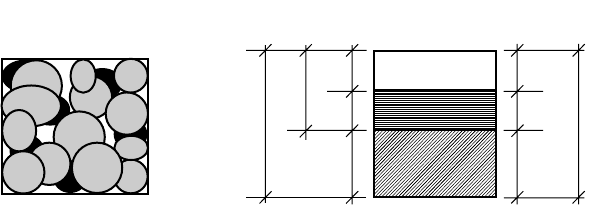
15-10 The Civil Engineering Handbook, Second Edition
individually or in combination. Given some known values of mass, weight, volume, or density (or
relationships among them), it is often necessary to calculate other values. This section defines the terms
commonly used in geotechnical engineering to describe such relationships and provides worked examples
of typical calculations.
The Phase Diagram
In a typical volume of soil the three components are arranged in a complex mixture. To visualize the
relationships among the components when performing weight-volume or mass-volume calculations,
drawing a phase diagram is recommended. Much like checking equilibrium with a free body diagram in
statics, completing and balancing a phase diagram with numerical values of all quantities permits cross-
checking the solution. Figure 15.4 shows an element of soil and the corresponding phase diagram. All
solid particles in the element are taken as an equivalent single mass at the bottom of the diagram. Above
the solids is the water—also represented as a single equivalent mass—and above that, the air. On the
sides of the diagram are variable names; numerical values are entered here during calculations. On the
left side are the total volume V, the volume of solids V
s
, the volume of water V
w
, and the volume of air
V
a
. The combined volume of water and air is the volume of voids V
v
. On the right side are shown the
total weight W, the weight of solids W
s
, and the weight of water W
w
. The weight of air is negligible. For
problems involving masses, mass values are shown on the right instead of weights and given the equivalent
designations M, M
s
, and M
w
.
Volume Relationships
Vo lume relationships include the void ratio, the porosity, and the degree of saturation. The void ratio,
denoted e, is the ratio of the volume of voids to the volume of solids:
(15.6)
The porosity, denoted n, is the ratio of the volume of voids to the total volume:
(15.7)
The void ratio and porosity are related as follows:
(15.8)
(15.9)
FIGURE 15.4 Soil element and phase diagram.
e
V
v
V
s
------=
n
V
v
V
------=
n
e
1 e+
---------------=
e
n
1 n–
---------------=
Water
γ
S
γ
W
Air
Volume Weight
Solids
V
S
V
W
V
V
V
V
a
0
W
W
W
W
S
γ
© 2003 by CRC Press LLC
Soil Relationships and Classification 15-11
The degree of saturation, denoted S, is the ratio of the volume of water to the volume of voids. It is
commonly expressed as a percentage:
(15.10)
If all the soil voids are filled with water and no undissolved air is present, the soil is said to be saturated.
Weight and Mass Relationships
The water content (or moisture content), denoted w, is the only relationship involving weights or masses.
It is the ratio of the weight of water to the weight of solids or, equivalently, the ratio of the mass of water
to the mass of solids:
(15.11)
Unit Weight
The ratio of the weight of a material to its volume is its unit weight, sometimes termed specific weight or
weight density. The unit weight of water, g
w
, is 9.81 kN/m
3
in the SI system and 62.4 lb/ft
3
in the English
system. The unit weight of solids, g
s
, varies with the mineralogy of the soil particles but is commonly in
the range of 26.0 to 27.0 kN/m
3
or 165 to 172 lb/ft
3
. The total unit weight of a soil (the solids-water-air
system), denoted g, is the ratio of the total weight to the total volume occupied:
(15.12)
The saturated unit weight, denoted g
sat
, is the total unit weight that would be obtained if the air voids
were filled with an equal volume of water (S = 100% and V
w
= V). The dry unit weight, denoted g
d
, is
often termed the dry density and has particular importance in field control of soil compaction. It is the
ratio of the weight of solids to the total volume:
(15.13)
Note that the dry unit weight matches the weight of a single component—the solids—with the entire
volume of solids, water, and air. It does not represent the unit weight of any component or consistent
set of components, but rather provides a measure of how much solid material by weight is in the total
volume of a container, such as an earthmover or a compaction mold. The buoyant unit weight or effective
unit weight, g¢, is equal to the saturated unit weight minus the unit weight of water, g
w
:
(15.14)
The buoyant unit weight is sometimes used to directly calculate vertical effective stresses below the
water table instead of calculating total stresses and subtracting pore pressures.
Density
The term density is used herein to denote the mass-to-volume ratio of a material. However, some
references, particularly older ones, use the term to describe unit weight. Density is denoted by r. Because
m = W/g, the unit weight terms defined above can be converted to mass densities as follows:
(15.15)
S
V
w
V
v
------
100%¥=
w
W
w
W
s
--------
M
w
M
s
-------==
g
W
V
-----
W
s
W
w
+
V
s
V
w
V
a
++
------------------------------==
g
d
W
s
V
------
W
s
V
s
V
w
V
a
++
------------------------------==
g
¢
g
sat
g
w
–=
r
g
g
--
M
V
-----==
© 2003 by CRC Press LLC
